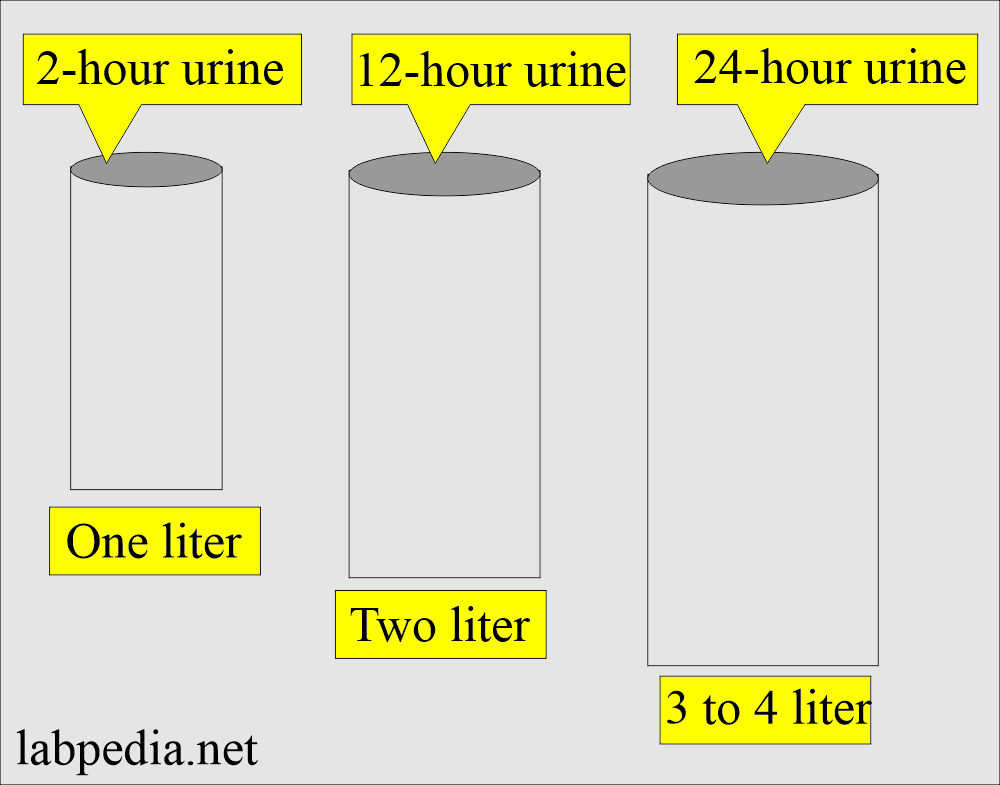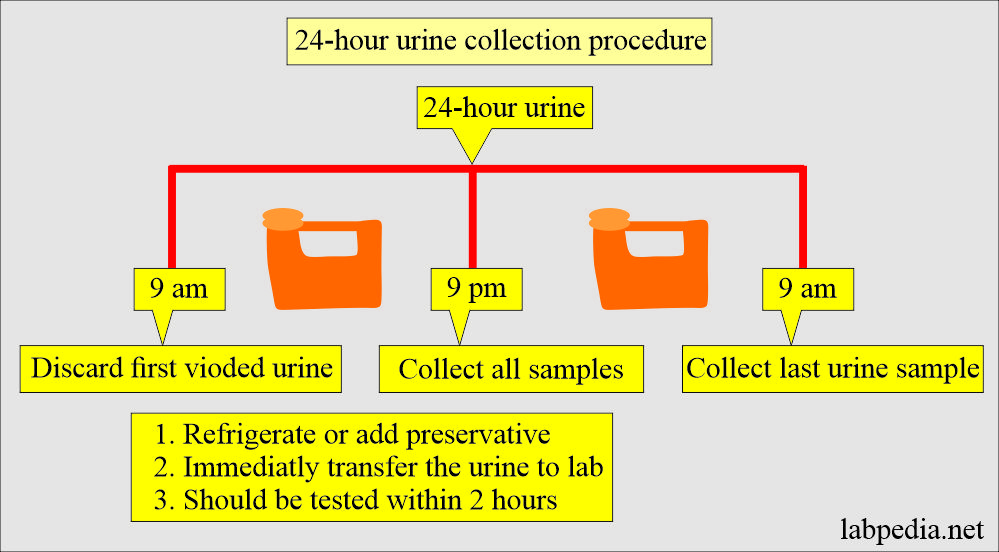Urine 24-hours Collection, and Preservatives
Urine 24-hours
- Please provide the following written instructions to the patient for 24 hours of urine collection.
What is the purpose of 24-hour urine collection?
- The main purpose of 24-hour urine collection is to quantify certain substances excreted in the urine.
- Urine samples may also be collected for 1 and 4 hours.
- It helps in assessing kidney function.
What are the precautions for Urine 24 hours?
- A complete and accurate collection must be made to properly evaluate the required test on 24-hour urine samples.
- Drink fewer fluids during the collection time unless advised by the doctor.
- Avoid alcoholic drinks.
- Avoid certain foods, beverages, and medication that may affect the result.
- Do not test the chemicals needed before the required time of collection because the excretion of the substance in the urine varies.
What type of container is used for urine collection?
- Urine containers should be clean and sterile. It should have a tightly fitting lid to avoid evaporation, contamination, and urine spillage.
- Label the urine bottle with name, age, sex, and collection date.
- For a 2-hour urine collection, the one-liter container is sufficient.
- For 12-hour collection, the 2-liter container is sufficient.
- For 24-hour collection, you may need a 3 to 4-liter container.
- A single container is preferred because of the mixing of the analytes needed for estimation.
- The single container also avoids the loss of urine.
How will you describe the procedure for 24-hour urine collection?
- Empty the urinary bladder when you get up in the morning.
- Note the time …………… and date ………..
- Discard the first urine in the bladder (empty bladder), and start the clock.
- Thereafter, all the urine samples will be collected in the container.
- From now on, collect the urine in a clean bottle or container.
- Collect all the urine passed during the day and night.
- Note the time, which will be the same………….. and date (after 24 hours) …………..
- Empty your bladder into the container (last-moment urine sample) and make the final collection of urine at the same time.
- Keep the urine in the refrigerator and, if possible, bring it to the laboratory as soon as possible after the collection.
- There may be a need to add chemicals like hydrochloric acid or boric acid in some of the tests as preservatives.
What are the Urine preservatives?
What is the purpose of urine preservative?
- Preservatives prevent bacterial growth.
- Preservatives prevent the decomposition of the substance to be tested.
- Preservative prevents the precipitation of the substance from being tested.
- Refrigeration during and after urine collection is the best preservative.
- Acidification of the urine (pH below 3) is used for calcium, steroids, and VMA.
- Sodium hydroxide (NaOH) is used as a preservative to test porphyrins, urobilinogen, and uric acid.
What is the mechanism of urine preservatives?
- Urine preservatives work:
- Prevents decomposition of the urine.
- Prevents the growth of bacteria.
- Prevents the metabolism of the microorganism.
What are the examples of Urine Preservatives?
- Hydrochloric acid (HCL) 6 mol/L needed 30 mL for a 24-hour urine sample.
- A boric acid of 10 grams per 24-hour urine sample is needed.
- Nitric acid (HNO3) 6 mol/L, 15 mL needed for 24-hour urine.
- Sodium carbonate (Na2CO3), 5 grams needed for 24-hour urine.
- Acetic acid 50%, 25 mL needed for 24-hour urine.
- Thymol preserves protein and ketones. It prevents bacterial growth.
- Toluene preserves for a long period of time. It prevents bacterial growth.
Urine preservative for various chemicals:
| Chemical to be tested | Preservative | Instructions | Advantages |
|
|
|
|
|
|
|
|
|
|
|
|
|
|
|
|
|
|
||
|
|
||
|
|
||
|
|
||
|
|
What preservative will you select for a particular purpose?
- Glucose Stability: Sodium fluoride.
- Hormone Testing: HCl or acetic acid.
- Culture and Sensitivity: Boric acid or refrigeration.
- Microscopic Analysis: Formalin or refrigeration.
- No preservative is needed: When urine is immediately tested.
How can you summarize the normal urine picture?
| Physical features | Chemical features | Microscopic findings |
|
|
|
Questions and answers:
Question 1: What preservative you will use for estimation of uric acid?
Question 2: What is the purpose of urine 24-hour sample?



Very Very Information post…………
Thanks for the encouraging remarks
I have given the link that how to collect 24 hours sample